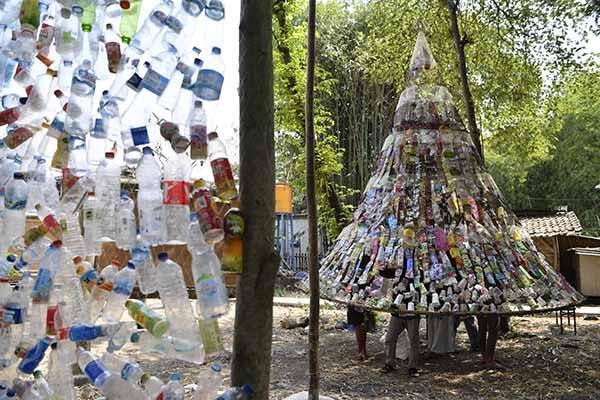Plastic Museum in Indonesia: Educating Public of Plastic Waste's Hazard
Environmental activists and Ecological Observation and Wetlands Conservation (Ecoton) have built a plastic museum with 3F (Fish Fersus Flastic) in Gersik, East Java Province of Indonesia.
The plastic museum is made from used plastic waste collected from several rivers in Surabaya, the capital of East Java province.
The 3F Plastic Museum Exhibition Coordinator, Firly Mas'ulatul Janah, said that the idea of this program was her big concern over the lack of awareness of residents who still throw plastic waste into the rivers and the government's reluctance to provide waste processing facilities.
"This museum is an education to reduce the use of single-use plastic, which pollutes Indonesia's rivers," she said.
She explained that the state of plastic waste pollution in the rivers of East Java, especially in urban areas such as Surabaya, Sidoarjo, Mojokerto and Gresik, could no longer be tolerated.
In this exhibition, visitors are invited to explore underwater life, which shows the suffering of fish and other water creatures that live on the riverside by plastic waste.
"It is time to stop using plastic by reducing the use of single-use plastics, be it mineral water bottles, sachets products, plastic bags, straws, diapers and styrofoam," she appealed.
Ecoton, an environmental movement, built a 10 meters long hallway filled with thousands of plastic bottles totaling 3,455 pieces. This aisle depicts rivers being surrounded by plastic waste.
"The plastic museum is our means of educating the public about the dangers of plastic waste," Firly said.
According to the Central Statistics Agency (BPS) data, in 2021, Indonesia produces about 64 million tons' plastic waste per year. A total of 3.2 million tons of them are dumped into the sea.
Firly, the anthropology alumnus of Airlangga University, Surabaya, explained that Indonesia is the second-largest plastic waste contributor after China.
"Every year, we (Indonesia) contribute 3.2 million tons of plastic waste to the oceans, the second largest in the global level after China which contributes 6.4 million tons," said Firly.
Meanwhile, according to Waste4Change data, Indonesia produces 175,000 tons of waste per day. Of this amount, only 7.5% can be recycled into compost. The rest, as much as 10% of waste is stockpiled, five percent of waste is burned, and 8.5% is not managed.
"This plastic museum is excellent. I have never thought of making a plastic bottle aisle," said Nadifa Rahma, a local student at the Government Senior High School who visited the exhibition together with her school colleagues.
"If I were a fish, I want humans to be aware not to throw plastic waste into the river because it is harmful," she said.
Unlike Jelita Camela, who comes from the same school, she feels miserable to see a lot of garbage in the rivers, which can contaminate the water as plastic waste contains many chemical elements that will disrupt the life of aquatic biota.
The impact of plastic waste in Indonesia will increase and the quality of the environment will be threatened. This will pose a threat to the ecosystem. Therefore, this exhibition invites the public to switch to using environmentally friendly products.
"Let's work together in educating the public to reduce single-use plastic and sort out our domestic waste," invites the head of the Gresik Family Welfare Development (PKK), Mrs. Nurul Haromaini, after being amazed at the 3F Plastic Exhibition at Ecoton.
Ecoton, in this 3F activity, deliberately built a plastic exhibition hangar to remember that "We must reduce the use of plastic!"
The 3F Plastic Exhibition at Ecoton has been organized since September. This event acknowledged a lot of positive responses from government agencies, environmental activists and the surrounding community.
"That's how we scream every day that plastic is threatening our mother earth. Plastics harm the environment and are eaten by fish and ingested by humans," wrote Ecoton on its social media page.
Radio Veritas Asia (RVA), a media platform of the Catholic Church, aims to share Christ. RVA started in 1969 as a continental Catholic radio station to serve Asian countries in their respective local language, thus earning the tag “the Voice of Asian Christianity.” Responding to the emerging context, RVA embraced media platforms to connect with the global Asian audience via its 21 language websites and various social media platforms.



















